Streets for People / Time to Reimagine Car-Centric, Mainland Style Searstown and Kmart into Island-Friendly Centers with Housing
We know how to make mainland visitors feel welcome don’t we? Driving into Key West along N. Roosevelt Boulevard they must feel right at home. Four big, wide-open, fast-moving lanes of traffic and a middle turn lane. Huge signs announcing McDonalds, Chevrolet, I-Hop, Wendy’s, Sears, Dunkin, Pizza Hut, Home Depot, Five Guys, Kmart, Denny’s and more. Acres of parking lots fronting retail that’s a football field length away from the road, necessitates even more signs to coax you inside. Why it looks and functions like anywhere on U.S. Route 1 on Florida’s East Coast and U.S. 41 on Florida’s West Coast. Or just about anywhere in mainland Florida. Save for the ubiquitous FDOT palm trees along the water lining the Promenade, a first timer might not realize they’ve arrived in Paradise.
The announcement last week that Kmart is closing in March and Publix has bought the entire Searstown Plaza give Key West an opportunity remake these car-dependent retail strip malls into denser, mixed-used centers that can include housing and better accommodate bikes and transit. Just because these properties are currently configured as bygone era strip shopping doesn’t mean they have to stay that way. But to change them we may need to provide the property owners some carrots in the form of bonus density, parking variances and height waivers to get what we want. Done right, perhaps we can make these shopping strips less like the mainland and more like the island paradise we love while making another dent in our lack of affordable and workforce housing.
We Need More Affordable Housing on the Island of Key West
The number one issue on our island is affordable or workforce housing. Yes, the approximately 126 units at the Lofts in Bahama Village at Truman Waterfront is a nice start. But most of the affordable/workforce housing in the pipeline is beyond Cow Key Bridge. There’s 208 new units at the Quarry on Big Coppitt and under construction on Stock Island there are 280 units at Wreckers Cay and 104 units on College Road. We need affordable workforce housing on THIS island because it enables residents to walk, bike and transit to get around and brings overall affordability for their residents’ down. That and keeping housing on our island is good for our local businesses too.
When recently asked about the Mallory Square, Diesel Plant and Duval Street planning projects, Paul Menta of First Legal Rum and Distillery and head of the Shop Mom and Pop Key West group said:
“Without local housing it doesn’t matter what Duval Street and Mallory Square looks like. There’s going to be nobody to clean it and nobody to cook. We face extreme staffing shortages right now. The problem I see is everybody is working to the max, which means eventually, customer service is going to start to fade because people are going to become very frustrated as they’re burned out and overworked trying to compensate for the lack of staff and employees. We need to direct all our focus to figuring out how we can get people in housing. Possible grants or incentives for people to rent to workers in Key West are options. And when we build there is a lot of space available that we haven’t even fully looked at, from the Navy and everywhere else. This has to be taken care of as our present dictates what our future is actually going to be and look like.”
Paul’s right in saying nothing else matters if we don’t first get more affordable housing. He is in line with the results from the Strategic Plan which says affordable housing is our number one priority. It identifies “initiating a dialogue with shopping center owners” and the military in addition to owners of the Poinciana property, Porter Place/School Board site, and Harris School as places for homes.
With Kmart closing and Publix just having announced their acquisition of the entire Searsontown complex, NOW is the time to initiate discussions about folding in new housing.
The End of Big Box in Key West is Part of a Larger Trend in Retail Reshuffling
Last week in the Citizen and Keys Weekly we learned that our local Kmart is closing in March. Sears closed in August 2020 and has remained empty. Last week the Keys Weekly also broke the story that the entire Searstown complex was bought by the Publix Corporation, and they haven’t yet divulged their plans.
What’s happening here, isn’t isolated to Key West. Retail has undergone a great reshuffling over the last decade or so as the popularity of big box stores and malls surrounded by a sea of parking have waned in the face of e-commerce. Especially in urban areas. Covid has exacerbated the trend forcing many of the best-known brands to either close shop altogether like Sears and Kmart, consolidate like Bed, Bath and Beyond or seriously enter the online delivery business like Walmart.
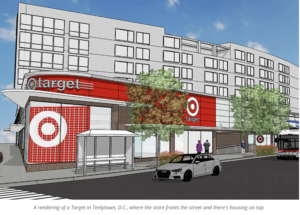
From Big Box Retail Surrounded by a Sea of Parking to Smaller Big Box Stores as the Nucleus of Urban Centers
Another trend that’s been taking place for a while now is to place these stores in urban “centers” as the magnet for mixed-used developments that include smaller retail footprints than the same stores would have in strip malls, and the inclusion of office space and housing. In connecting retail to living and work, where some customers are already on site, the trend includes a need for less surface parking and/or building parking under multi-story complexes. The best of these new developments aren’t as car-dependent and make it easy to get to by transit and bicycling.
There are a lot of examples of this kind of development. Think of the places you’ve visited. When I lived in Washington, D.C. next to my job site there were downtown centers like Clarendon Crossing that included Crate & Barrel, Whole Foods, Ethan Allen, twenty smaller stores, office space, condos and town homes. The Columbia Heights DC USA complex near my home included one of the first urban Targets, Best Buy, Bed Bath & Beyond and much more all in multi-story buildings with parking garages tucked away and housing next door.
We Have to End Key West Parking Minimums for Retail and Other Uses
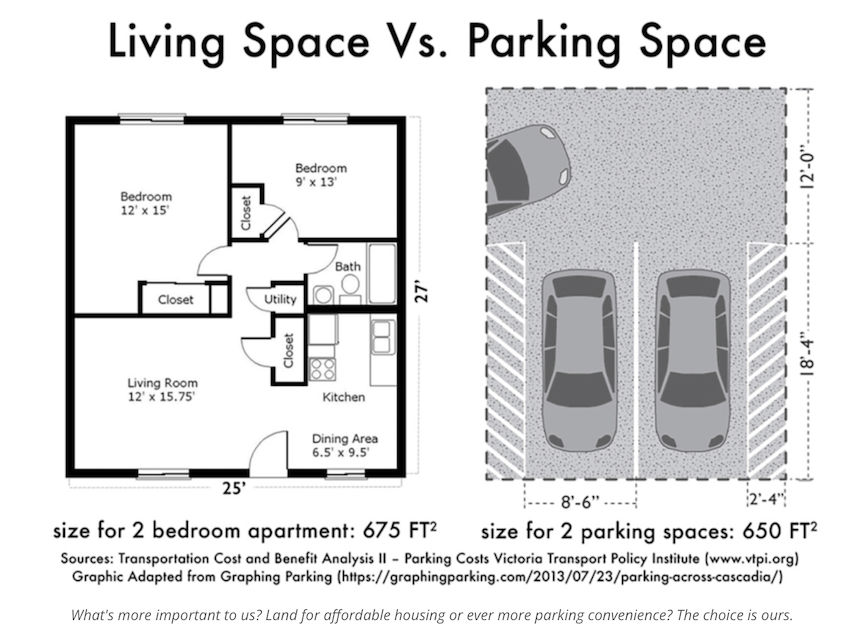
At 4.2 square miles, land in Key West is at a premium. We have no more open space to build on. So, in a small, urban area like ours, using all this land for mainland style, suburban surface parking is a colossal waste of space. The first thing we need to do is ditch the parking minimums, tied to suburban standards on the mainland, our zoning code requires of various uses. Freed from having to supply a certain amount of parking spaces, like one parking space per 45 sq. ft of restaurant space, one parking space per 300 sq. ft of retail, and one parking space per bedroom or hotel room, the Key West code requires, an owner/developer is then free to use the space saved on other uses, like housing.
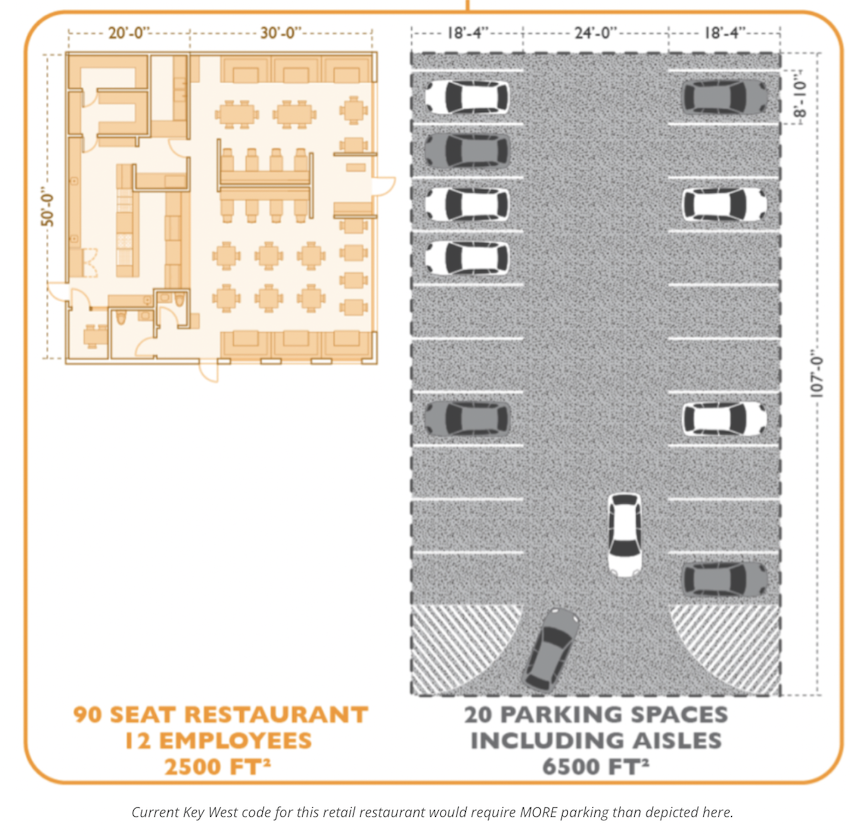
Here’s an example or two of what we’re talking about. I found this graphic that depicts a 2,500 sq. ft. 90 seat restaurant requiring 20 parking spaces. This is what it looks like spatially. The parking takes up twice the space of the restaurant. Key West requires one parking space per 45 sq. ft. of serving area. So being conservation, say just half of the 2,500 sq. ft. restaurant below is serving/consumption area. 1,25 sq. ft. divided by 45 = 28 parking spaces. Even more than the example here. Does this make any sense at all?
Now multiply this by all the retail uses in any of the N. Roosevelt Boulevard strip shopping centers and you begin to understand why we have seas of parking surrounding retail on the island. We tend to require the parking to accommodate the maximum number of vehicles that might show up on Black Friday in car dependent places.
Look at this from another perspective. Living space vs. parking space. It takes roughly the same amount of land to accommodate a small 2-bedroom condo as it does to park two cars. Two cars. On an island where we lack affordable housing, it makes the trade-off even more stark.
So, for starters we need to agree not to require any minimum amounts of parking on these properties and we should provide incentives to put the parking in structures below other uses. That may mean granting variances on density and height restrictions too.
Publix Gets in On the Mixed-Use, Urban Center Trend
With the news that Publix bought the entire Searstown property we did a quick Google search to see if the growing Southern supermarket chain does more than just build grocery stores in strip malls. Low and behold we found they do. Just in 2021 Publix announced it is opening a new downtown Tampa store as part of a 325-unit residential complex. In Atlanta’s West Midtown they are part of a 9-acre mixed-use complex that includes their 42,00 sq. ft store, 200,000 sq. ft. of office space, 105,000 sq. ft. of retail, 349 apartments, 18 townhomes and a 161-room hotel. In Miami Publix is part of a mixed-use development in West River with 325 apartments. In Raleigh, NC Publix is part of a mixed-use development that includes their 45,600 sq. ft. store, another 50,000 sq. ft. of retail and 417 apartments. That was just from the first page of our Google search.
Having Our Cake and Eating It Too
It is good for Key West that Publix does these kinds of developments. Other retailers from Target to Whole Foods do too. So, asking them to do something different won’t be a stretch – but we have to make it easy for them to do. As Sears and Kmart have closed, many people have taken to social media yearning for another big retailer as a replacement. Walmart, Target, Whole Foods, Trader Joes, BJ’s, Best Buy, Costco and many more have all been mentioned. Not that we really need these places, nor is it likely they’d come to such a small demographic footprint, but just for the sake of argument, having another big retailer doesn’t mean we have to have it in a mainland style strip mall. We could theoretically have a new Target that includes affordable housing all packaged in a more urban development with the buildings abutting the street and the parking underneath the mixes of housing and office uses.
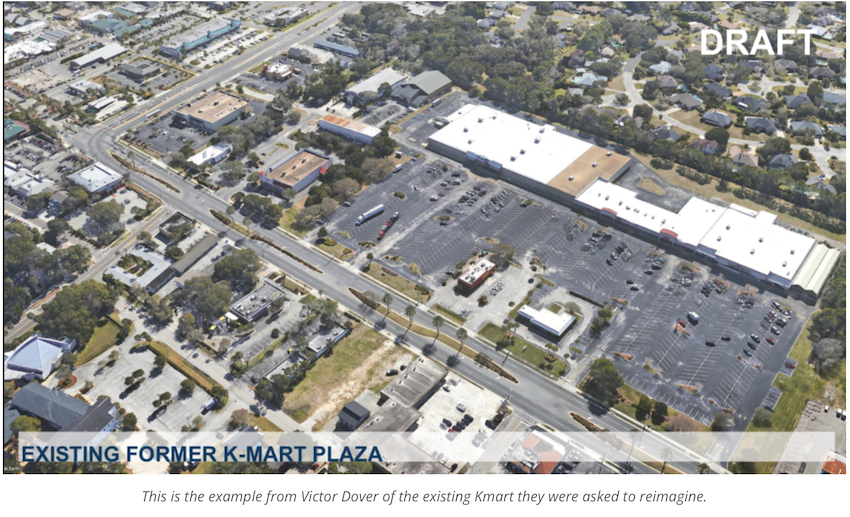
I reached out to the amazing planning guru Victor Brandon Dover of Dover Kohl & Partners Town Planning who I follow on Twitter and he shared with me that redoing strip malls is fairly common and provided a couple of examples. The first is a little study his firm did for a beach town with a defunct Kmart. The illustrations below show how the strip mall could be transformed into a mixed-use project. He also shared: “As for Publix buying Searstown, consider studying the precedent of Baldwin Park, which integrates a modern Publix with a real main street & mixed use, including civic, housing, offices, etc. Start here and zoom out: https://g.page/Bigote_BP?share.” If you go to the use, switch to the satellite view, and fly around the area. In a lot of ways, it is what could be done on N. Roosevelt Boulevard.

Commissioner Hoover and Kaufman Already Out Front on These Issues
Last spring Commissioners Mary Lou Hoover and Sam Kaufman hosted meetings and a community survey on N. Roosevelt Boulevard. They sought input from property owners, business owners, residents, and visitors. They asked about increasing buffers between commercial and residential, incentivizing smaller and more inviting signage, placing parking behind commercial uses, and more. Here’s what they heard from the 770 people that responded to the survey, in order of importance:
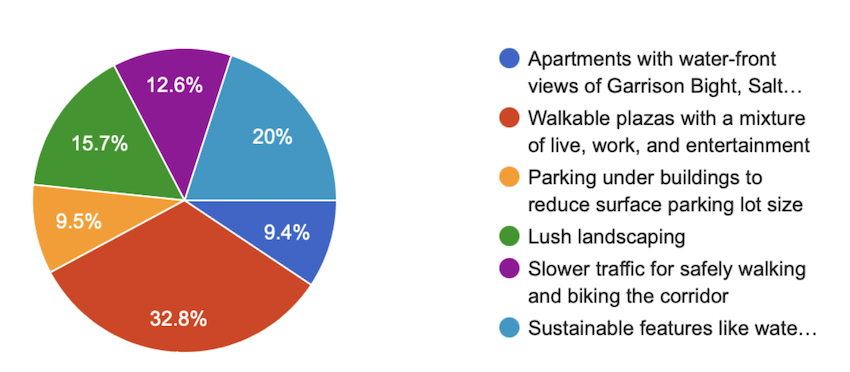
74% Bike and pedestrian friendly designs
71% Increased landscaping, shade, and street trees
51% Increasing landscaped space between residential and commercial areas
44% High quality design and architectural standards for a Key West feel
37% Mixed-use residential and commercial structures
36% Creating safe pedestrian paths in parking lots
34% Parking behind/Incorporated into structures
When asked “If our shopping plazas redeveloped to mixed-use plazas, what changes would you like to see?” the 759 respondents said:
In a Keys Weekly story on January 29, 2021 story about a workshop on affordable housing an idea was mentioned about putting housing above shopping centers on North Roosevelt – Searstown, Key Plaza and Overseas Market. Commissioner Kaufman said: “Let’s meet with the shopping center owners. We’ve already heard that Publix is interested in building employee housing. And there looks to be a ton of space behind the Winn Dixie center.” Keys Weekly reported that other ideas included zoning changes that would increase density and/or height limits so more apartments can be added to existing neighborhoods.
When I asked Commissioner Hoover about her work on this issue and the news at Searstown and Kmart she said:
“I have continued to move forward with the revitalization of N. Roosevelt reviewing potential lighting, signage, and landscaping changes I’ve been working with the developer who owns the Overseas Market shopping center, and he is in the process of redeveloping that center to include affordable housing. I’m also in contact with the leasing agent and property manager for the other two centers. I should know more about their plans in the near future. We’ve included FDOT in our meetings and are requesting priority for an ingress/egress study along the Boulevard. That study was also one of Key West’s priorities sent to the Florida Keys Transportation Coordination Committee (FKTCC) of which I’m a member. As for the Overseas Market affordable housing, or either of the other two plazas, they would have to apply for BPAS units like any other housing. I think this community is in the right frame of mind to back the building of more affordable housing, if it’s done with respect for the neighborhood.”
This is good news.
Time to Get Creative and Support Innovative Work
Mayor Johnston and Commissioner Kaufman reminded me that the Commission enacted legislation in 2019 that increased the current amount of housing that can be built in the General Commercial zone of these shopping centers from 16 residential units per acre to 40 units per acre if the units are affordable/workforce housing. That’s also good news. The Mayor also told me in reaction to the Searstown news: “I read Mandy’s story with great interest. In fact, I am meeting with some community members to discuss how we proactively attract the type of businesses that we want in Key West later this afternoon.” More good news.
Kmart closing and Searstown being bought by Publix offer a golden opportunity to remake these mainland style, suburban parking lots into mixed-use centers that are nice to look at, more pedestrian and bicycle friendly and that include a mix of uses, including much needed affordable housing, that exude Key West charm. The City will likely need to offer parking variances and height and density bonuses/waivers to the owners in order to get this done. Change is hard to come by but our community needs to wholeheartedly support the revisions needed to make it happen. In the end our whole island will be better for remaking these outdated strip shopping centers that look like they belong in another place and time, not our beloved Key West.
# # #
You can find the nearly 50 KONK Life Streets for People column articles here and here and the 13 most recent stories below:
- Mallory Sq., Diesel Plant, Duval Street and Bahama Village Projects Create Synergy to Bolster Downtown; January 14, 2022
- 3 Reasons You May Not Have Thought of for Voting YES on 3.2 on January 18; January 7, 2022
- Countdown of 2021’s Most Important Bike, Walk and Transit Stories – Is Our Glass Half Full or Half Empty? – Part 2: The Case for a Glass Half Full Year; December 17, 2021
- Countdown of 2021’s Most Important Bike, Walk and Transit Stories – Is Our Glass Half Full or Half Empty? – Part 1: The Case for a Glass Half Empty Year; December 10, 2021
- Countdown of the 10 Most Important Bike, Walk and Transit Stories of 2019 and 2020 Revisited; December 3, 2021
- Counting Down the Top 10 Most Popular Stories of 2021; November 26, 2021
- Prominent Locals Say We’ve Got a Lot to Be Thankful for When It Comes to Biking and Walking in Key West; November 19, 2021
- City Fails, Again, to Make South Roosevelt Boulevard and Promenade Safer for Bikes, Pedestrians and Vehicles; November 12, 2021
- It’s Time to Eliminate Free On-Street Parking for Visitors Downtown; November 5, 2021
- It’s Official – Uber-Like On-Demand Transit Coming to Key West in December; October 28, 2021
- D.C. Baseball, Key West, Tattoos and the World Series; October 22, 2021
- Meet Local Ryan Stachurski – The City’s New “Bike Guy”, October 8, 2021
Chris Hamilton is founder of the local advocacy group Friends of Car-Free Key West & Duval Street/Historic Downtown. He’s a native of the District of Columbia, where for a couple decades+ he led nationally renowned efforts promoting transit, bike, walk and smart growth for Arlington County, VA’s DOT. Chris has lived in Key West since 2015. He lives downtown and works and volunteers for a couple non-profits. Follow him on Twitter here and his blog here.
[livemarket market_name="KONK Life LiveMarket" limit=3 category=“” show_signup=0 show_more=0]



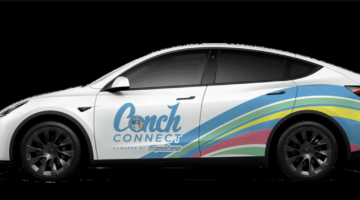
No Comment